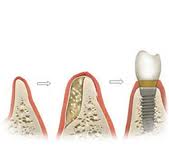Bone Grafting at Ardent Dental, North Vancouver
Why Bone Grafting is Needed
In many cases, a dentist may need to increase the amount of bone in a patient’s jaw. Bone grafting is often required when the jawbone is damaged or has receded, as a preparatory step before a dental implant or restoration. Sufficient jawbone volume is crucial for the success of these restorations.
Causes of Insufficient Jaw Bone Volume
Several factors can lead to insufficient jawbone volume:
- Periodontal (Gum) Disease and Infections: These conditions progressively attack gum tissue and can eventually damage the jawbone if left untreated.
- Tooth Extraction: It is estimated that following a tooth extraction, patients lose 40-60% of the bone surrounding the extraction site within three years.
- Injury: Trauma to the jaw or other dental injuries can cause the jawbone to recede.
Advances in Bone Grafting
Recent developments in bone grafting techniques have made implant treatment possible in cases that were previously deemed impossible. While increasing the amount of available bone can add to the cost and time of treatment, and introduce additional procedures and risks, it greatly improves the chances of successful dental implants.
Types of Bone Grafting Techniques
Bone grafting techniques can be grouped into two main types:
- Extensive Bone Grafting: This type is performed as a separate surgery from the implant placement. It aims to make significant changes to the shape and size of the dental ridge to allow for a stable implant, usually placed several months later. These procedures are typically carried out by specialists such as oral surgeons or periodontists.
- Minor Bone Grafting: In this type, the jaw may already have enough bone to place the implant, but not enough to completely cover the sides of the implant. These grafts are generally small and are performed at the time of implant placement.
Visit Ardent Dental Lynn Valley Centre in North Vancouver to learn more about bone grafting and to discuss your specific needs and treatment options.
Will a bone graft be needed in my case?
Certainly the larger procedures can be predicted and planned well in advance; however, the smaller grafts done at the time of implant placement cannot always be predicted, and must be available to the surgeon in order to give your implant the best chance of success. It is vitally important that you and your dentist agree on this point before the start of the surgery.
Where does grafted bone come from?
Are all types of bone graft material equally effective?
Is bone grafting safe?
Consider receiving human donor bone or animal bone elements to be the same as receiving blood from the blood bank, with a similar level of risk. The processing techniques used to prepare the freeze dried bone and the animal bone elements results in graft materials which have proven to be extremely safe. Also, only materials from a reputable, well managed national tissue bank are used. There is, theoretically, an extremely small chance that infectious disease could be transmitted through either of these materials.
Be sure to discuss the possibility of bone grafting with your Lynn Valley dentist in North Vancouver and reach a firm understanding before the surgical procedure starts.
For more information on bone grafting, please see video below


